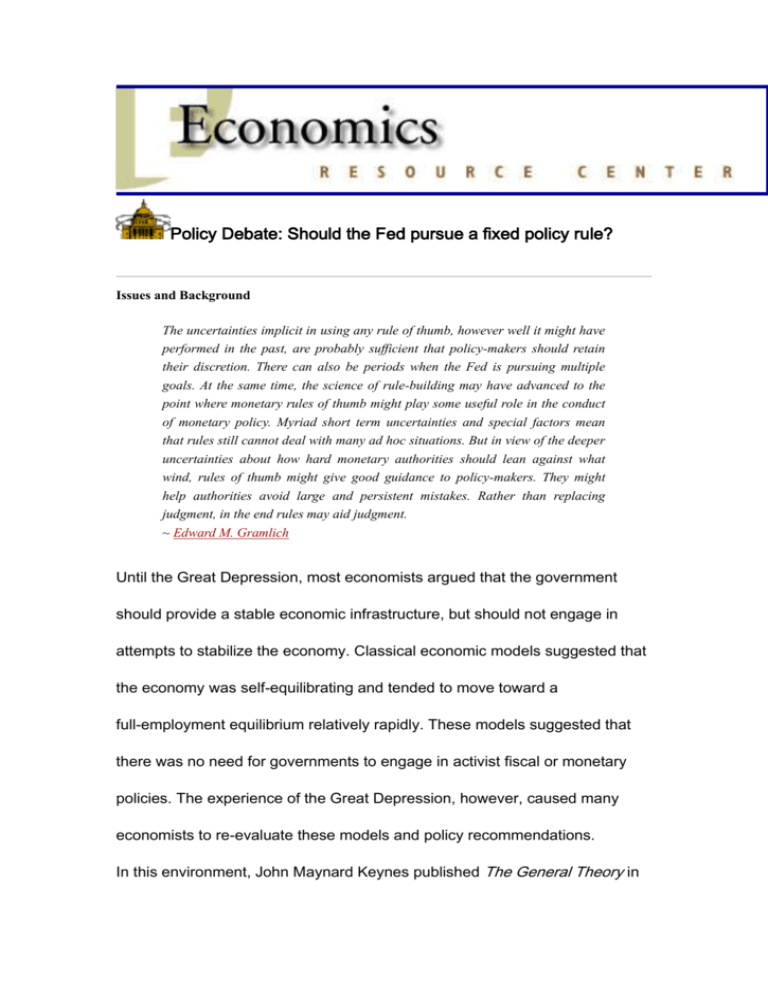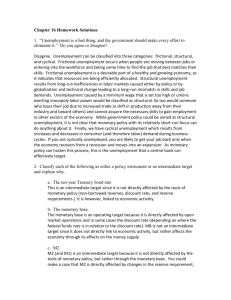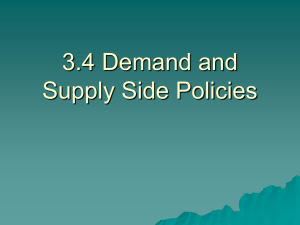
Policy Debate: Should the Fed pursue a fixed policy rule?
Issues and Background
The uncertainties implicit in using any rule of thumb, however well it might have
performed in the past, are probably sufficient that policy-makers should retain
their discretion. There can also be periods when the Fed is pursuing multiple
goals. At the same time, the science of rule-building may have advanced to the
point where monetary rules of thumb might play some useful role in the conduct
of monetary policy. Myriad short term uncertainties and special factors mean
that rules still cannot deal with many ad hoc situations. But in view of the deeper
uncertainties about how hard monetary authorities should lean against what
wind, rules of thumb might give good guidance to policy-makers. They might
help authorities avoid large and persistent mistakes. Rather than replacing
judgment, in the end rules may aid judgment.
~ Edward M. Gramlich
Until the Great Depression, most economists argued that the government
should provide a stable economic infrastructure, but should not engage in
attempts to stabilize the economy. Classical economic models suggested that
the economy was self-equilibrating and tended to move toward a
full-employment equilibrium relatively rapidly. These models suggested that
there was no need for governments to engage in activist fiscal or monetary
policies. The experience of the Great Depression, however, caused many
economists to re-evaluate these models and policy recommendations.
In this environment, John Maynard Keynes published The General Theory in
1936. He argued that the government should engage in discretionary fiscal
and monetary policies designed to shift the economy toward a full-employment
equilibrium. While Keynes accepted the argument that an economy
experiencing a severe recession or depression may eventually move towards
a full-employment equilibrium in the long run, he argued that this adjustment
process could require a good deal of time. In a famous quote, Keynes noted
that, "In the long run, we're all dead." Keynes' arguments were rapidly
accepted by the economics profession and provided a theoretical basis for
activist fiscal and monetary policies.
By the 1950s and early 1960s, Keynesian economic models and policy
prescriptions were generally accepted by policymakers. These policies
appeared to be quite successful when used to stimulate the economy. The
primary focus of macroeconomic policy during this period was on avoiding a
recurrence of a severe recession. Little emphasis was placed on inflation since
it was believed that the costs of inflation were relatively low. Advocates of
Keynesian policies believed that it was possible to use discretionary fiscal and
monetary policy to "fine-tune" the economy, achieving full employment with
only a moderate amount of inflation.
As long as unemployment and inflation rates both remained low, there was
little reason to question the use of discretionary policies. Increased
government expenditures related to both the Vietnam War and the "war on
poverty" resulted in greater inflationary pressures in the U.S. during the mid-
and late-1960s. The Arab Oil embargoes of the early 1970s resulted in further
inflationary pressures. This inflation, however, unlike other recent periods of
inflation, was accompanied by rising unemployment rates. This "stagflation,"
as it came to be known, could not be explained by the simple Keynesian
models that were in general use during this period.
Milton Friedman, and other monetarists, were quite willing to provide an
alternative explanation for these phenomena. Friedman argued that
discretionary policies could have a short-run effect on the level of output.
Monetarists argue, however, that the economy, left to itself, will move to a
full-employment equilibrium quite rapidly. Thus, discretionary policy changes
will not be able to influence the level of output in the long run. According to the
monetarists, changes in the money supply supply will only affect the price level
in the long run. Friedman argued that the growing inflation rate experienced
during these periods was due to an attempt to maintain a level of
unemployment that is below the "natural rate of unemployment," the rate of
unemployment that was consistent with price stability. While Friedman
believed that discretionary policy has an affect on the economy, he argued that
the actual effect was more often the reverse of the desirable effect because of
the existence of lags in:
recognizing the need for a policy change,
implementing the new policy, and
the effect of the policy on the economy.
Because of the existence of these lags, Friedman argued that the government should rely on fixed
policy rules and should avoid discretionary policies.
Robert Lucas, Thomas Sargent, Neil Wallace, and other "new-classical
economists" provided an alternative critique of discretionary fiscal and
monetary policies. This critique relies on the concept of "rational expectations."
Individuals that possess rational expectations take all available information into
account in predicting future outcomes. If individuals possess rational
expectations, discretionary monetary and fiscal policy changes that are
anticipated by the public will cease to have an effect on unemployment. If
everyone believes, for example that a monetary expansion will occur that will
result in 5% inflation next period, wages and contracts negotiated today will
include a 5% adjustment for the anticipated inflation. Under this model,
monetary policy changes that are anticipated will only affect the price level and
will not effect unemployment in the short run. While a faster than expected
growth in the money supply may reduce unemployment in the short run, such a
"surprise" ceases to surprise people if it is occurs often enough.
New classical economists, therefore, agree with monetarists in supporting a
fixed monetary policy rule. They generally advocate a fixed money growth rate
rule and argue that low inflation is likely to result only if the Fed announces,
and maintains, such a policy. While the Fed may be able to lower
unemployment, in the short run, by an unexpectedly large increase in the
money supply, the use of such a policy would make the Fed's subsequent
announcements less credible and would encourage higher future inflation
rates.
New Keynesian economists, on the other hand, follow in the Keynesian
tradition of advocating discretionary monetary (and fiscal) policies. While they
differ from earlier Keynesians in placing greater emphasis on the role of
aggregate supply, they share a belief that the economy, left to itself, often
adjusts relatively slowly. New Keynesians believe that the appropriate use of
discretionary monetary and fiscal policies may reduce the costs associated
with recession or periods of high inflation.
Another area of contention concerns the choice of a policy rule. One type of
rule is a fixed money growth rule (as advocated by many monetarists and new
classical economists) that requires a constant (and low) rate of growth in the
money supply without regard to economic circumstances. At the other extreme
are rules that vary the rate of monetary growth according to realized inflation
and unemployment rates according to a predetermined formula.
Related materials may be found in the debate that examines whether the Fed
should pursue a zero inflation target.
Primary Resources and Data
Rebecca Hellerstein, "The Impact of Inflation"
http://www.bos.frb.org/economic/nerr/rr1997/winter/hell97_1.htm
In this Boston Fed online article, Rebecca Hellerstein provides a good discussion of the
actual and perceived economic costs of inflation. This article summarizes a large volume
of relatively technical recent studies in a very simple manner.
Alan S. Blinder, "The Strategy of Monetary Policy"
http://minneapolisfed.org/pubs/region/95-09/reg959a.cfm
In this September 1995 article, Alan S. Blinder, the Vice Chairman of the Federal Reserve
Board of Governors, discusses practical problems in the conduct of monetary policy.
Blinder provides a good summary of the measurement issues making it difficult to
achieve monetary targets and examines the difficulties of conducting monetary policy in
an uncertain environment.
Mark Bernkopf's Central Banking Resource Center
http://patriot.net/~bernkopf/
This web site contain links to the websites of virtually all central banks that maintain an
internet presence. These web sites often contain information about the conduct of
monetary policy in these countries.
Owen F. Humpage, "Monetary Policy and Real Economic Growth"
http://www.clev.frb.org/research/com/1296.htm
Owen Humpage discusses the short- and long-run relationships that are expected to exist
between the rate of growth in the money supply and the rate of economic growth. He
provides a good intuitive discussion of both the relevant economic theory and the
empirical evidence concerning these relationships.
Carl E. Walsh, "The New Output-Inflation Trade-off"
http://www.frbsf.org/econrsrch/wklyltr/wklyltr98/el98-04.html
In this online Federal Reserve Bank of San Francisco publication, Carl E. Walsh
summarizes the areas of agreement and disagreement concerning the relationship between
changes in the money supply and changes in real output in the short run and in the long
run. He notes that there is general agreement that monetary policy has no effect on the
level of real output in the long run. Walsh argues that recent research focuses on a tradeoff
between variability in output and variability in inflation.
Federal Reserve District Banks
http://www.oswego.edu/~economic/fed.htm
This page contains a list of links to the home pages of Federal Reserve District Bank web
sites. Each of these sites contains online articles that discuss the conduct of monetary
policy.
Different Perspectives in the Debate
Joint Economic Committee, "Establishing Federal Reserve Inflation Goals"
http://www.house.gov/jec/fed/fed/goals.htm
In this April 1997 study, the Joint Economic Committee recommends the adoption of a
price stability target for the Fed. The committee argues that such a policy would help
preserve the Fed's credibility and would encourage economic growth.
Antonio Martino, "Monetary and Fiscal Rules"
http://www.cis.org.au/Policy/autumn98/aut9801.htm
Antonio Martino provides a summary of the arguments in support of a fixed monetary
rule in this online article appearing in Policy (Autumn, 1998). He provides an excellent
nontechnical summary of the evolution of the economic debate concerning the use of a
fixed monetary rule from the 1930s to the present day. Martino notes that while a large
proportion of economists support the use of a monetary rule, there is substantial
disagreement over which rule should be applied. Martino discusses problems with a
variety of monetary rules are discussed in this article.
Giandomenico Majone, "Temporal Consistency and Policy Credibility: Why
Democracies Need Non-Majoritarian Institutions"
http://www.iue.it/RSCAS/WP-Texts/96_57.html
In this European University Institute Working Paper, Giandomenico Majone examines
why democratically elected governments generally rely on autonomous agencies to
control their monetary policy. Majone argues that this is done primarily so that monetary
policy announcements remain credible. He argues that democratically elected
governments engaging in discretionary monetary policy often face incentives that
encourage them to alter monetary policy from previously announced objectives. This
problem of "time inconsistency" results in a loss of credibility. With a loss in credibility, it
becomes difficult for monetary policymakers to achieve policy objectives. Independent
monetary policy agencies, however, are able to focus on longer term objectives and are
more likely to engage in monetary policies that are time consistent.
Edward M. Gramlich, "Monetary Rules"
http://www.federalreserve.gov/boarddocs/speeches/199802272.htm
Federal Reserve Board Governor Edward M. Gramlich discusses alternative monetary
policy rules at the Eastern Economic Association's Samuelson Lecture held February 27,
1998. He discusses the advantages and disadvantages of a variety of policy rules
including: a gold standard, a constant rate of monetary growth rule, inflation targeting,
and Taylor's rule (this rule incorporates a feedback effect in which the policy is
automatically adjusted when the inflation rate and/or real GDP diverges from their target
levels). Gramlich argues that Taylor's rule seems to perform the best, but argues that
policymakers should maintain discretion in implementing monetary policy. He suggests
that rules should be used to aid, but not replace, judgment in establishing monetary policy.
Otmar Issing, "Monetary Theory as a Basis for Monetary Policy: Reflections of a
Central Banker"
http://www.internetional.se/issingitaly.htm
Otmar Issing, a Member of the Board of the Deutsche Bundesbank, argues that monetary
theory does not provide an adequate basis to guide central bankers in the day-to-day
conduct of monetary policy. He notes that macroeconomic theorists often disagree, and
many economic theories that were once generally accepted by economists were
eventually proven to be wrong. Issing also notes that the public may respond to policy
changes in ways that make it impossible to achieve the original policy objectives. He
argues that there are problems associated with the use of either a fixed policy rule or a
discretionary monetary policy. Issing recommends that policymakers must rely on both
economic theory and practical experience in establishing monetary policy.
Federal Reserve Bank of San Francisco, "What is Taylor's rule and what does is say
about Federal Reserve monetary policy?"
http://www.frbsf.org/education/activities/drecon/ask298.html
This online document discusses the Taylor Rule, a policy rule suggested by John Taylor of
Stanford University. It is noted that this rule provides a very close approximation to the
policies that have been pursued by the Fed during Alan Greenspan's chairmanship.
John Taylor, "The Taylor Rule"
http://research.stlouisfed.org/conferences/homer/rule.html
In this excerpt from Inflation, Unemployment, and Monetary Policy (MIT Press, 1998),
John Taylor provides a simple statement of and justification for the Taylor Rule.
John Taylor, "Monetary Policy Rule Home Page"
http://www.stanford.edu/~johntayl/PolRulLink.htm
John Taylor's Monetary Policy Rule Home Page contains links to a diverse and interesting
collection of online monetary policy resources. In addition to links to papers and
discussions that are designed for the general public, there is also a collection of links to
more technical studies of the use of monetary policy rules. This is a superb place to visit
for those interested in finding out more about monetary policy rules in theory and
practice.
Athanasios Orphanides, "Activist Stabilization Policy and Inflation: The Taylor Rule in
the 1970s"
http://www.federalreserve.gov/pubs/feds/2000/200013/200013pap.pdf
In this February 2000 Federal Reserve Board working paper, Athanasios Orphanides
shows that the behavior of the Fed during the 1970s was very close to the behavior
suggested by the Taylor rule. Since the economic outcomes of this period are often
viewed as being undesirable, he suggests that this may raise some questions concerning
the usefulness of the Taylor rule. (The Adobe acrobat viewer plugin is required to view
this document. You may download this viewer by clicking here.)
Kevin Dowd, "A Rule to Stabilize the Price Level"
http://www.cato.org/pubs/journal/cj15n1-3.html
In this Cato Journal article, Kevin Dowd argues that central banks should attempt to
pursue a target of maintaining a stable price for a price-index futures contract. He argues
that a commodity basket standard of money would be preferred to using a single
commodity (such as gold) as a monetary standard. Dowd suggests that a price-index
futures contract would have all of the advantages of using a commodity basket standard
without the associated storage or handling costs.
Carl E. Walsh, "Nobel Views on Inflation and Unemployment"
http://www.frbsf.org/econrsrch/wklyltr/el97-01.html
In this Federal Reserve Bank of San Francisco publication, Carl Walsh discusses the
similarities and differences between the theoretical contributions and methodological
approaches of Milton Friedman and Robert Lucas.
Laurence H. Meyer, "The Global Economic Outlook and Challenges Facing Monetary
Policy Around the World"
http://www.federalreserve.gov/boarddocs/speeches/current/19990225.htm
In this February 25, 1999 speech, Federal Reserve Governor Laurence H. Meyer
discusses some of the problems associated with the conduct of monetary policy. He
argues that in 1998 and early 1999, the Fed has allowed the federal funds rate to change
from the level that would be suggested under the Taylor rule. He suggests that this
departure from recent practice was due to recent changes in internal and external
economic circumstances: the Russian default and devaluation, weaker foreign growth
rates, and uncertainty about the natural rate of unemployment.
Federal Reserve Bank of Minneapolis, "An Interview with Janet Yellen"
http://minneapolisfed.org/pubs/region/95-06/int956.cfm
In this June 1995 interview, Janet Yellen discusses some of the problems facing monetary
authorities in trying to achieve goals of low unemployment and price stability. She
emphasizes the complications that occur as a result of long time lags in the response of
the economy to monetary policy changes.
Federal Reserve Bank of Minneapolis, "An Interview with Milton Friedman"
http://minneapolisfed.org/pubs/region/92-06/int926.cfm
Milton Friedman was the 1976 recipient of the Nobel Prize in Economics. In this 1992
interview, Friedman states his views on the conduct of monetarist policy (and a variety of
other topics). He suggests that the Fed has a very poor record in conducting discretionary
monetary policy.
Federal Reserve Bank of Minneapolis, "Interview with James Tobin"
http://minneapolisfed.org/pubs/region/96-12/tobin.cfm
James Tobin was the 1981 recipient of the Nobel Prize in Economics for his work on
money demand. In this 1996 interview, Tobin states his views on monetary theory (as well
as on other policy issues). He argues that in favor of discretionary policy in which the Fed
considers both unemployment and inflation rates in establishing monetary policy. Tobin
also argues that there should be more political control over the Fed.
©2003 South-Western College Publishing. All Rights Reserved
webmaster | DISCLAIMER










